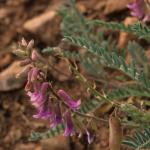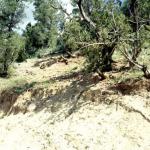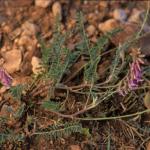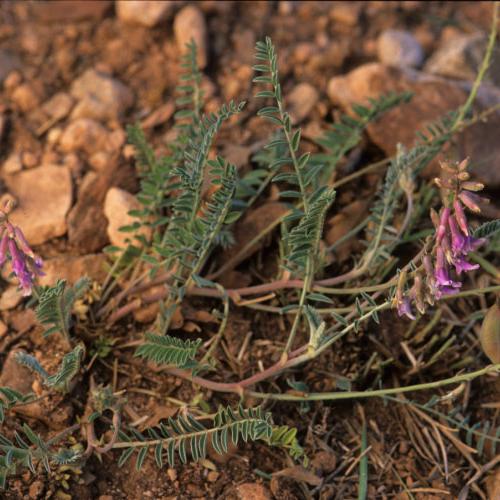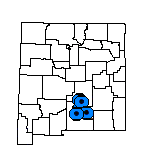Description
Perennial from a taproot, strigulose or pilose with basifixed hairs; stems clustered on a root crown, spreading, distally ascending, 0.5-3 dm long; leaves pinnately compound, 6-20 cm long; leaflets 19-40, becoming smaller up the rachis, mostly elliptic, 4-15 mm long, 2-4 times longer than wide, grayish or greenish; stipules free; inflorescences within foliage, flowers pea-like, 6-20 per raceme, initially contiguous, then loosening and declined; calyx tube usually swollen at base, 7-9 mm long, usually purplish, lobes 2-4 mm; corolla 13-19 mm long, dull purple, greenish-purple to pink; ovules 28-33; fruits declined to humistrate, sessile, 1.5-3 cm long, 7-10 mm in diameter, curved, unilocular, or with narrow septum to 1 mm, and then sub-bilocular, deciduous, dehiscent, dorsal and ventral faces initially only depressed but sulcate at maturity, valves thick and pulpy when fresh, woody with age, coarsely cross-ridged, slightly hairy. Flowers late May to October.
Similar Species
This plant is unlikely to be mistaken for other milkvetches in its range and can be distinguished by the characteristic combination of 19 or more leaflets per leaf, free stipules, basifixed hairs, purplish flowers, and nearly naked, thick, pulpy pods that become somewhat woody with age.
Distribution
New Mexico, Lincoln, Otero, and western Chaves counties, in the Sacramento Mountains.
Habitat
Dry hillsides and valley bottoms, in piñon-juniper woodland or ponderosa pine forest; 2,090-2,580 m (6,850-8,450 ft).
Conservation Considerations
Current land uses apparently do not pose a threat to this species. It appears to respond favorably to soil disturbance and is frequently found on roadcuts and overgrazed ranges.
Important Literature
*New Mexico Native Plants Protection Advisory Committee. 1984. A handbook of rare and endemic plants of New Mexico. University of New Mexico Press, Albuquerque.
Barneby, R.C. 1964. Atlas of North American Astragalus. Memoirs of the New York Botanical Garden 13:1-1188.
Isely, D. 1998. Native and naturalized Leguminosae (Fabaceae) of the United States (exclusive of Alaska and Hawaii). Monte L. Bean Life Science Museum, Brigham Young University, Provo, Utah.
Wooton, E.O. and P.C. Standley. 1913. Descriptions of new plants preliminary to a report upon the flora of New Mexico. Contributions from the U.S. National Herbarium 16:109-196.

